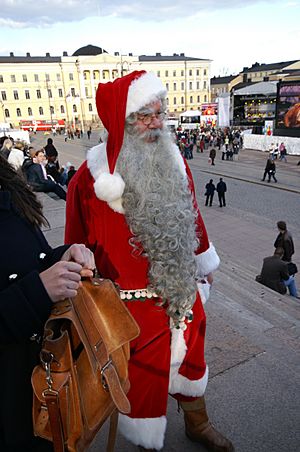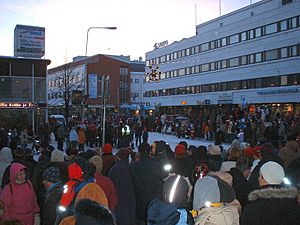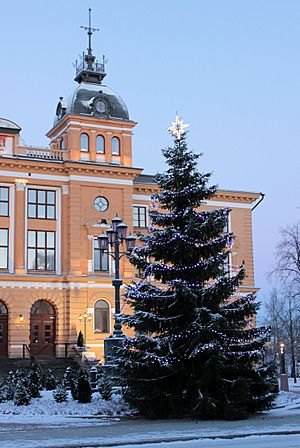Christmas in Finland facts for kids
Christmas in Finland starts on Christmas Eve, just like many other public holidays. The evening of Christmas Eve is very important and a paid day off for most grown-ups. Unlike other holidays, public transport almost stops completely on Christmas Eve afternoon. The Christmas season finishes on Epiphany.
History of Finnish Christmas
In Finland, the Christmas season traditionally begins on Tuomas’s nameday (December 21) and lasts until St. Knut's Day (January 13). An old saying reflects this: "Good Tuomas brings Christmas, bad Nuutti takes it away."
Before 1774, Finland used to celebrate a third and fourth Christmas Day. These were December 27 (for John the Evangelist) and December 28 (for the Massacre of the Innocents). However, King Gustav III of Sweden decided to cut them down to just two days. This was because important people thought that long holidays made workers too lazy. The third and fourth Christmas Days were also called "little holidays." The Finnish Orthodox Church celebrates Christmas at the same time as other Western Christian churches.
Finnish Christmas traditions have taken some ideas from an old harvest festival called kekri. This festival used to happen around the time of All Saints' Day. In Finland, Sweden, and Estonia, the joulupukki (which means "Christmas goat") was once a person dressed up like a goat. They might have worn goat horns and a mask made of birch bark, along with a sheepskin coat turned inside out.
Feeding small birds at Christmas is a very old tradition. Farmers believed it brought good luck for their crops. They would put out a sheaf of barley or oats. Some people think that ancient Finns believed the spirits of the dead, like "soul birds," celebrated the mid-winter holiday with the living. They might have also thought birds brought good luck to their homes.
Some traditional Christmas decorations include himmeli (a hanging decoration made of straw) and the Yule goat. Decorations made from straw come from the old kekri harvest festival. The first Christmas trees arrived in Finland in the mid-1800s.
Attending an early-morning church service on Christmas Day is part of the Protestant tradition. People listen to the Christmas story and sing Luther’s hymn "Enkeli taivaan." In the past, the Lutheran church was very strict about attending this service. If you didn't go, you could be publicly scolded. Reading the Christmas story at home before the meal became popular in the late 1800s.
Having a sauna at Christmas is another old tradition. People would wash in the Christmas sauna before the celebrations. They might even leave food and drink for the house elf. Wealthy families started giving each other presents in the early 1800s. Christmas calendars arrived in Finland after the Second World War.
The tradition of visiting cemeteries to light candles on family graves started in the 1900s. It became very common at the graves of soldiers after the Winter War, and soon spread to other graves too. The old kekri tradition of leaving gifts for the dead moved to Christmas time. Today, lighting candles is a common way to remember loved ones.
Eating a lot at Christmas comes from the ancient Finns. It's connected to the farming year and the festival of light around the shortest day of winter. When most food was grown at home, eating a lot of meat at Christmas was a rare treat. Lutefisk (dried fish) and porridge are some of the oldest Christmas foods. In the 1800s, rice replaced barley in porridge. Casseroles, prune soup, and gingerbread biscuits became popular in the 1800s and 1900s, adopted from wealthier families. The Christmas ham replaced the kekri lamb, and in the 1940s, wild turkey also became an option.
Posti Group, the Finnish postal service, has been publishing special Christmas stamps since 1973.
Christmas has traditionally been a family celebration in Finland. However, in the 2000s, it has become more common for some people to spend Christmas alone.
Celebrating Christmas Today
Common Christmas decorations include spruce branches, a Christmas tree, Christmas wreaths, straw goats, himmelis, apples, candles, special Christmas tablecloths, Christmas flowers, outdoor torches, ice lanterns, and sheaves of grain.
To help nature, some people choose to decorate a tree in their garden or a nearby forest for the birds, instead of buying a cut Christmas tree. They decorate it with fat balls for the birds. Before opening presents, some families might light candles to remember those who have passed away. It is also very common to go to the sauna at Christmas.
The Finnish Yule table usually has different casseroles. These are often made from carrot, swede (lanttulaatikko), or potato (sweetened potato casserole). There are also various fish dishes, like cold smoked salmon, gravlax, and whitefish (graavisiika). On Christmas Eve, people often eat rice porridge.
See also





